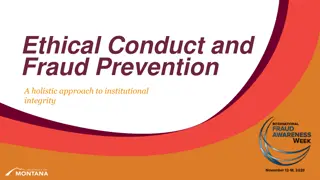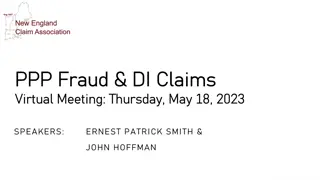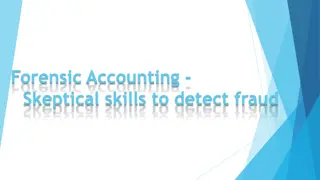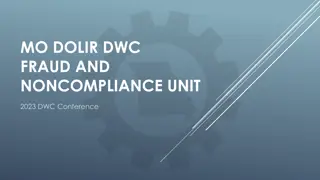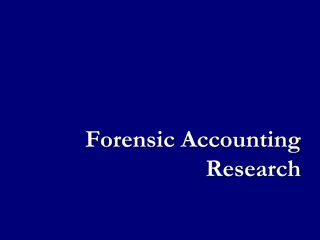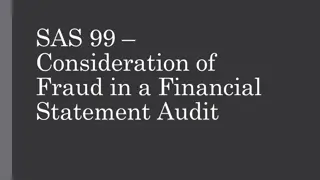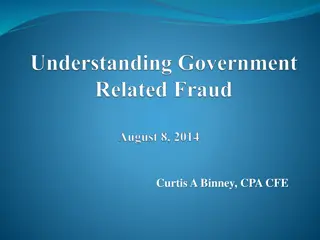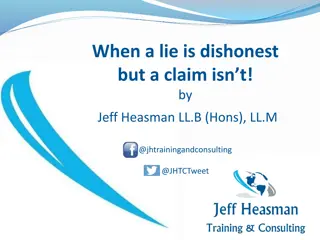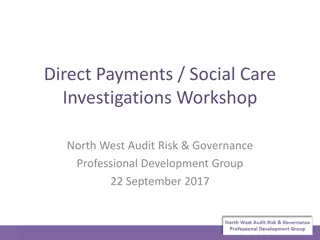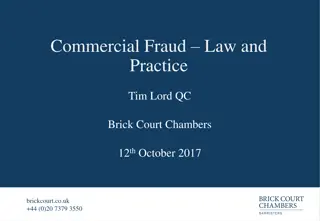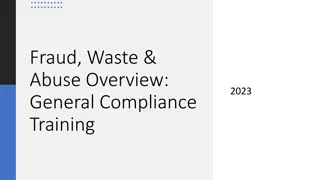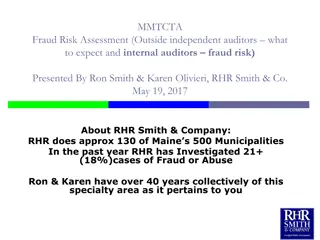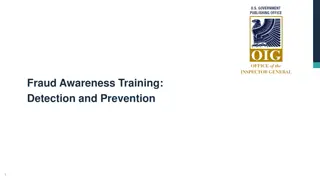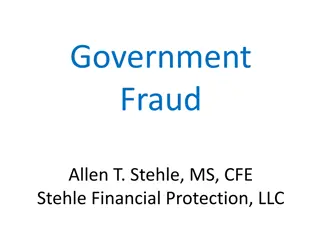Understanding Legal and Fraud Considerations in Engineering
Engineering teams must be aware of key legal requirements related to intellectual property and fraud to avoid costly rework and liability. Intellectual property issues, including software development, and the risk of fraud, especially in sales engineering, should be carefully managed to protect the organization and its stakeholders.
Download Presentation

Please find below an Image/Link to download the presentation.
The content on the website is provided AS IS for your information and personal use only. It may not be sold, licensed, or shared on other websites without obtaining consent from the author. Download presentation by click this link. If you encounter any issues during the download, it is possible that the publisher has removed the file from their server.
E N D
Presentation Transcript
ENGINEERING LAW AND HAZARD ASSESSMENT OF HEALTH WORKERS FOR ENHANCED OCCUPATIONAL SAFETY IN NIGERIA BY AJANI KEHINDE PATRICK PETROLEUM ENGINEWERING 17/ENG07/005
ENGINEERING LAW In Engineering, it s important to be familiar with some of the laws that might affect technical work. Generally speaking, members of the engineering team won t be subject matter experts in this area but the more that engineers are aware of key legal requirements, the less likely costly rework will be required, and the easier it will be to avoid any liability that might arise. Some of the basis of the engineering laws is given below: Intellectual Property: A Major Issue for Software Engineers Intellectual property can be a thorny issue for engineering teams to navigate. Businesses vigorously defend their intellectual property because so much future revenue and competitive advantage might depend on it. IP issues can arise in any area of engineering, but they are especially prominent in software development, where features and methodologies can infringe on intellectual properties that the developers themselves might not be aware of. In large enterprises, legal risks are assessed well before a project is undertaken. The engineering manager should be briefed on these issues and may choose to disseminate high-level information to the team. Whatever the case, the manager should work to be familiar with the legal footprint of similar and competing products. Most issues arise not from intentionally using others intellectual property, but from substantially reproducing their work independently. In addition to avoiding unintentional legal entanglements with other companies, engineers also typically take pains to safeguard their own employer s IP. On sensitive projects, engineers are often subject to non-disclosure and confidentiality agreements. These require them to be cautious about how they communicate technical details that are valuable to their employer. It also requires them to safeguard that technical information even when they are using it in lawful ways. Acting negligently in a way that causes data to be hacked or stolen, or even lost, can have legal repercussions.
Fraud: Sales Engineers Beware All enterprises that produce tangible products of any kind need to be aware of the risk of fraud. The basic definition of fraud is a false representation of a matter of fact that deprives another of legal rights and induces the victim to act in a way that advantages the party committing fraud. In many ways, fraud can be understood as lying by omission or commission in a way that causes legal harm to another person. Harm in this case can mean physical injury, damage to reputation, loss of earnings, or simply the loss of money an individual spent on a product based on false claims. A victim of fraud can also be entitled to punitive damages, an amount of money that is awarded by a court to punish an individual or enterprise for misconduct in the hopes it won t happen again. How does an engineering organization fit into avoiding fraud liability? Engineers should be careful of any claims they make that might be taken to indicate the presence of a feature or advantage that doesn t exist or the absence of a potential risk or hazard that does exist. Such misrepresentations can take place in internal communication, end-user documentation, press statements, and a variety of other contexts. Sales engineers must be especially careful about the presentations and other collateral used to persuade potential clients to purchase a product or service. Such materials are usually kept on file by major clients throughout the duration of a contract and even afterwards and liability can extend far into the future.
Regulatory Compliance: Especially Important in Sensitive Industries Engineering managers working in sensitive areas such as medical devices will often need to have detailed knowledge of the compliance issues that apply to them. While virtually all products have certain legal safety standards, those that represent an especially high risk to the public often go through several rounds of compliance checks before they are ever presented to the government agency responsible for verifying their suitability for sale. In compliance-focused industries such as finance and healthcare, every team in the enterprise has a role in ensuring compliance. As regulations change, updated training and resources should become available well in advance of any changes taking effect. To protect their interests, engineers should also be proactive in tapping resources like professional conferences that can help them adjust to any changes efficiently.
When it comes to Engineering Law & Liability, Everyone Has a Role to Play Virtually everyone who works with the public in any capacity has to minimize their legal liability in some form or fashion. Engineers may have higher stakes in the sense that issues may have serious repercussions but they also have the benefit of others in the enterprise bringing legal knowledge to the table. Doing background research before each project can reveal some of the major legal risks attached to it. Engineering managers shouldn t hesitate to tap their company s resources to learn more in the early stages of work. Taking a course in Engineering Law and Engineering Management is also a major step toward building the engineer s effectiveness.
HAZARDS Physical hazards Noise and vibration can both independently pose significant health risks (e.g. from drill floors, shakers, sack rooms, generators, compressors and mixers). The typical approach, where noise cannot be mitigated at source or via engineering controls, has been to establish noise control zones requiring the use of hearing protection, based on area noise measurements [1]. Some regulators require area measurements to be used for comparison between installations [3]. Design guides on noise levels have been area based, as part of asset integrity maintenance (machines get noisier as they age, proactive maintenance can contribute significantly to lowering area noise). The use of hand-held vibrating tools is widespread on offshore installations (e.g. grinders, needle guns, impact wrenches, air drills and chipping hammers). This creates the possibility for hand arm vibration syndrome in workers who use these tools routinely. Various forms of radiation and thermal extremes are also relatively common on offshore platforms. Exposure to extreme heat and direct sunlight in tropical areas and to extreme cold in high latitudes can become significant sources of health risk dependent on the geographical region.
Chemical hazards Chemical hazards Published exposure data from systematic sampling of hazardous agents on upstream operations are limited or published some years ago. Since benzene is a natural component of crude oil and natural gas, a few studies have reported data on benzene exposure. Substances, such as hydrogen sulphide (H2S), are usually well controlled through sealed systems, permit to work systems, gas purging, area and personal monitoring, training, emergency plans, etc
Biological hazards Food-poisoning outbreaks are typical manifestations of biological hazards in the offshore workplace. They tend to occur more commonly in less developed areas, often related to poor hygiene associated with water dispensers, ice makers and ice cream machines. Also galley space can be limited, so cold storage can be deficient. Airborne diseases can spread rapidly through ventilation systems on offshore installations because accommodation is pressurized and living space is usually at a premium. Robust health risk management is required to control health risk from potential Legionella contamination of water pipes, particularly in showers of accommodation blocks and air-conditioning plants.
Ergonomic hazards Ergonomic hazards generally refers to health problems due to the interaction between the following: (i) the postures people are forced to adopt to reach, act on or operate the objects and equipment they work with and (ii) the nature and time history of the application of force on those objects. The critical factor that identifies a health issue as being ergonomic is that the injury arises because the way the environment and equipment are arranged requires people to adopt postures, movements, apply force and read material in conditions that are potentially damaging to health in order to complete what is expected of them in the normal course of their work.
Psychological hazards Psychological hazards are different from other occupational hazards (e.g. noise and chemicals) because The level of stress within an organization varies both rapidly and significantly over time; Stress occurs in hot spots in an organization and is rarely uniform; The effort required to conduct a full objective assessment of stress and controls is high and should not be undertaken lightly; Comprehensive stress and control assessments actually impact on stress; There is some evidence that stress in an organization or population is normal and often transient and Currently available data does not directly measure stress while interpretation is difficult and often counterproductive.
Hazard Assessment And Control Measures Hazard assessment Hazards identification was conducted by 2 complementary assessment methods and the outputs of both methods were used in LOPA and ETA risk analysis. In an attempt to identify hazards, the results of the what if method was considered as input data for the HAZOP process using the standard hazard identification (HAZID) procedure. Data obtained from the HAZOP analysis was used to assess risks using the LOPA technique). Based on the results of HAZOP analysis, 4 hazards from node 2, 3, and 4 were selected for determining scenarios. The levels of risks were determined according to the risk matrix. More likely scenarios with significant consequences were selected. The purpose of this step was to reduce the number of scenarios in order to manage their study. Generally, 4 scenarios in the first and 4 scenarios in the second gas sweetening unit with the same hazards were selected. For each scenario, an analysis of root causes and consequences and the assessment of frequency and level of risk were conducted. Then, the levels of risks associated with each scenario were determined using the LOPA method considering the IPLs, SILs, and their associated probability of failure on demand (PFD). SILs were defined as : SIL 1: The probability of failure per hour 10-5to <10-6, and PFD 10-1to <10-2. SIL 2: The probability of failure per hour 10-6to <10-7, and PFD 10-2to <10-3. SIL 3: The probability of failure per hour 10-7to <10-8, and PFD 10-3to <10-4. SIL 4: The probability of failure per hour 10-8to <10-9, and PFD 10-4to <10-5.
A control measure was needed. Think of a control measure as an action aimed to eliminate a hazard completely. If the hazard you've identified can't be eliminated, follow the hierarchy of controls to select the next-best control to mitigate the risk of an accident, incident, injury, or near-miss in the laboratory. There are several types of control measures that fall into three main categories (in order of priority and effectiveness): Elimination Engineering Administrative Personal Protective Equipment
The Hierarchy of Controls The National Institute for Occupational Safety and Health (NIOSH) in the US depicts the hierarchy of controls as an inverted pyramid with the most effective types of control measure (elimination) at the top and the least effective (personal protective equipment) at the bottom . Hierarchy of Controsl
Elimination and substitution are considered the most effective control measures. They are easiest to achieve for brand new processes. They can be more difficult to implement for existing processes, because new and/or more expensive equipment and materials may be required. Elimination Completely get rid of chemicals, materials, processes, and equipment that are unnecessary to your specific experiment. This is especially done in labs where various tests are carried out. Check if your equipment is well-worn, check dates, and refer to manufacturer's recommendations. Substitution Switch out processes, equipment, material, or other components, where applicable. Think about the amount of chemicals or potentially hazardous materials you are using. Can you reduce the amount and still achieve the desired result?
Engineering Controls Although elimination and substitution are separate controls in the hierarchy of control measures, they are also considered engineering controls because they are designed to remove the hazardous source before the worker makes contact. Other forms of engineering controls include: Isolation Reduce or remove hazards by separation in time or space. (May be particularly helpful in a shared lab space where different types of chemicals are being used.) Enclosure Place the material or process in a closed system. Transportation Move hazardous materials where fewer workers are present. Guarding and shielding Install guards to provide protection from moving parts or electrical connections. Shielding provides protection from potential explosions Ventilation Use fume hoods, fans, air ducts and air filters.
Administrative Controls While engineering controls seek to eliminate hazards, administrative controls aim to minimize a lab worker's exposure. Administrative controls are the existing safety rules and protocols put in place for workers in the lab to follow. Following are examples of administrative controls: Standard operating procedures and checklists; Training; Conducting a Job hazard Analysis prior to the start of an experiment; Limiting the time a person works with a certain material; Mandating that no one should work in the lab alone.
Personal Protective Equipment (PPE) Even though the hierarchy of control measures indicates PPE is the least effective of control measure, it should absolutely be used, in case other control measures fail. The success of PPE depends in part on whether or not lab workers actually use it. Eye goggles, hearing protection, and protective clothing (e.g., lab coats and gloves) are the most recognizable and most used PPE in the lab. PPE is always essential, and especially critical in the following circumstances: When engineering controls are not feasible or they do not totally eliminate a hazard; As a temporary control while engineering controls are being developed; In emergency situations.
Result Analysis The stated above can never be 100% efficient due to human error but can provide a means of preserving the health of several workers. Long term exposure however in small quantities could have a future damaging effect on former employees: some of which include cancer. The oil companies should ready their finances ensuring that pension fees are paid to appease for these future occurrence as the case may be. The HSE has been pivotal in the implementation of this methods of preventing health risks. HSE)as an alternative approach is of great importance. The aim of Health Safety Environment (HSE) is to evaluate, manage safety culture among the employees of an oil &gas sector. Improving safety, not only psychological and personal factors, organization and environmental factors should carefully be investigated, the actual problem be identified, appropriate solving methodologies be implemented, ultimately incidents rates will reduce. Individual unsafe behaviors, pervasive organization defects lie behind the majority causes of the hazards.
Result Analysis The stated above can never be 100% efficient due to human error but can provide a means of preserving the health of several workers. Long term exposure however in small quantities could have a future damaging effect on former employees: some of which include cancer. The oil companies should ready their finances ensuring that pension fees are paid to appease for these future occurrence as the case may be. The HSE has been pivotal in the implementation of this methods of preventing health risks. HSE)as an alternative approach is of great importance. The aim of Health Safety Environment (HSE) is to evaluate, manage safety culture among the employees of an oil &gas sector. Improving safety, not only psychological and personal factors, organization and environmental factors should carefully be investigated, the actual problem be identified, appropriate solving methodologies be implemented, ultimately incidents rates will reduce. Individual unsafe behaviors, pervasive organization defects lie behind the majority causes of the hazards.
CONCLUSION &DISCUSSION The current and recent historical situation with regard to health hazards in the offshore oil and gas industries can be summarized in three key points. Exposures to health hazards inherent to the raw product have been relatively stable over recent decades. After nearly a century of experience, and with relatively stable and mature processes, chemicals, and engineering facilities, the health risks offshore are relatively well understood and can be considered in the five categories forming the basis of the health risk assessment (HRA) process; There are few published studies presenting accurate and reliable data on health issues compared with the downstream (refining, etc.) petroleum industry. This is probably partly due to commercial sensitivities, as well as to the rapid and often relatively short-time scale of many upstream operations. The data that are available also tend to be western-centric, with very little information on health issues in the developing world. The upstream petroleum industry is facing major changes in the future macroeconomic climate in many ways





